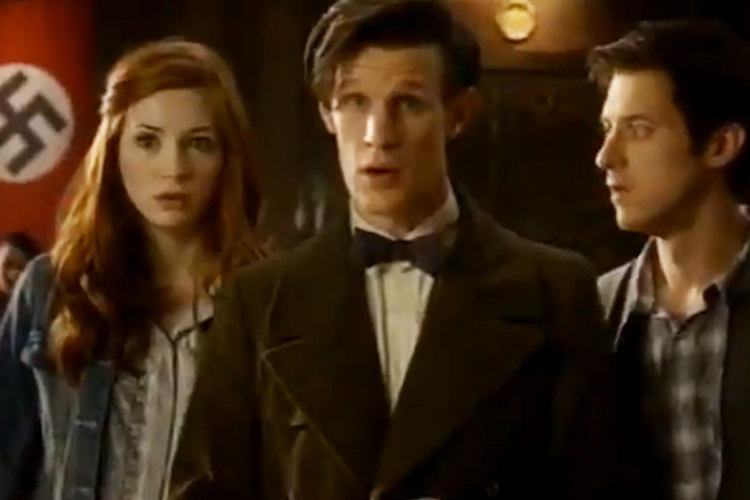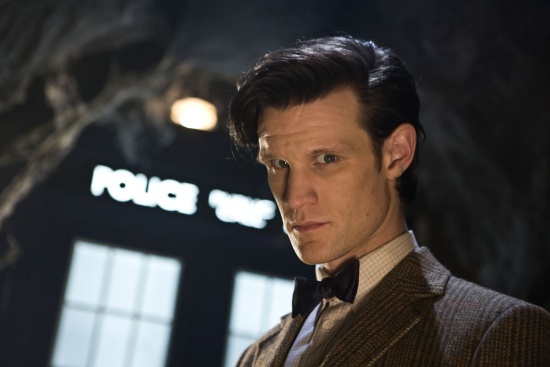MANKIND’S FUTURE IS in jeopardy. The threat doesn’t come from pollution, or climate change. There isn’t a giant meteor
hurtling through space. There isn’t even a lethal virus mutating in lab rats. Instead, the threat comes from a man in a Bacofoil suit. And a helmet decorated with exterior plumbing.
The year is 1982, and our silver nemesis is a Cyberman, one of a race of mechanically augmented humanoids intent on destroying Earth. Standing between him and our annihilation is The Doctor, a dandyish figure in cricket whites and a jaunty hat. He wears a stick of celery in his lapel. No matter how far The Doctor travels in space and time, the celery never seems to wilt. Today we’d suspect that it’s been genetically modified. In 1982, it’s simply part of the mystery that surrounds Doctor Who.
I came late to the seminal BBC sci-fi show. By the time I began to watch its weekly episodes it had already been on air for almost twenty years. I snuck through the TARDIS’s doors just as Tom Baker – the fourth actor to play the role of The Doctor – was on his way out. Replacing him was Peter Davison, a curious choice to inhabit one of the most iconic roles in science fiction. He was mild-mannered, pleasant-looking in a rather nondescript way, and best known for playing a genial countryside veterinarian in All Creatures Great and Small. But for two years, from 1982 to 1984, he became the center of my childhood world. He’s been camped there ever since.
When Hartnell suddenly departed from the show in 1966 audiences were left confused and dazed. The final episode of a story called ‘The Tenth Planet’ – also, coincidentally, the first story to feature the Cybermen – showed Hartnell’s face fading out, to be replaced with entirely different features. What did this mean? Who was this strange new man wearing The Doctor’s clothes?
It was here that Doctor Who’s moment of true genius occurred. Most TV shows change their cast without mentioning their obvious sleight of hand. Characters disappear, only to return played by different actors. The Doctor was unique. The scriptwriters made the bold decision to write this change of personnel – and the subsequent shift in tone – into the overall design for the show. The Doctor could regenerate whenever he sustained a life-threatening injury. As one version of The Doctor died, so another was born. The seeds of its longevity had been sown.
Two Cybermen face each other across a circular table. In the center is a projected image, showing The Doctor in three of his incarnations: Hartnell, Troughton, Baker. In each he does battle with the Cyberman race. He always wins. The Cyber Leader stabs his finger at the image and vows revenge.
For a race of emotionless robotically-augmented humans, the Cybermen always had remarkably short tempers. It was something that made them even more terrifying to a seven-year old. The Daleks – that other great foe of The Doctor – never truly scared me. To a pre-computer generation they must have seemed monstrously inhuman. I saw them as little more than a giant Atari console on wheels. It seemed more reasonable to be terrified of a sandwich toaster, or the invisible magic of the household microwave. But the Cybermen were different. Armed with super-strength, a hive mind, and some very big lasers, they were the schoolyard bullies of the universe. I hated them, even as I laughed at their stumbling movements and their bumbling attempts at domination. If The Doctor wanted to wipe them from the face of history, then that was alright with me.
The show’s four-part serial ‘Earthshock’ aired in March 1982, just as Doctor Who was starting to seep into my consciousness. It was the first time the Cybermen had appeared in my lifetime, and, in contrast to the rumor-mill of the Internet age, their return came as a surprise. Suddenly the Doctor’s old foes were back. And this time they had even bigger helmets. Like the episode’s montage of previous Doctors, the return of the Cybermen was a statement of intent. The show was approaching its twentieth anniversary, and the producers were firmly tying it to its roots. The faces were changing, but The Doctor lived on.
Looking back at the show’s output from the early 80’s through to its hiatus at the end of the decade, there’s something pleasingly amateurish about it. The aliens look like rejected Halloween costumes, the sets like mock-ups of an IKEA showroom. Many of the minor actors might have been culled from village theatre troupes. They point and gawp and deliver wooden lines as if they’ve never set foot on a TV set before. Even that generation’s versions of The Doctor – Peter Davison, Colin Baker and Sylvester McCoy – would have looked more at home in pantomime than in a major TV drama. The Cybermen were shambling extras in silver boiler suits, the Daleks wobbled about like barrels on wheels. As with many of the era’s sci-fi shows, time has not been kind toDoctor Who. You’d think a time traveler would have seen that coming.
And yet these flaws make little difference. I remember sitting sandwiched between my parents as The Doctor hurled himself and his companions into danger week after week. Luckily, The Doctor was always on hand to offer a quip and a smile, to take my hand and lead me through the labyrinths of time. There might be spaceships or distant planets, futuristic cities or mysteries from mankind’s past. To a sickly young boy in a suburban home that felt like a special kind of magic.
Then, with little warning and only a limited amount of fanfare, the series regenerated once again in 2005. Christopher Eccleston inhabited the lead role, bringing a sinister edge to the character. The Doctor had gone through dark incarnations before, but until now you’d never thought that he might steal your wallet. His adventures in time and space continued. After Eccleston came the dashing, gallant Doctor of David Tennant, forever running from place to place and sweeping women off their feet. By the end of Tennant’s tenure the show was finally hitting TV gold: American viewing figures were on the rise. It turned out that what sci-fi fans really wanted was a handsome Brit to sweep them off their couches. Matt Smith succeeded David Tennant, contributing a quirky humor that further cemented The Doctor’s cult status overseas. Bow ties and fezzes became all the rage at Comicon.
If you’ve paid any attention to the intergalactic media circus that surrounds Doctor Who, you’ll know that Smith is standing down from the show at the end of 2013. In his place comes Peter Capaldi, an actor best known for his X-rated rants in In The Loop. A college friend of Craig Ferguson, and the only Doctor to own an Oscar (for the short film Franz Kafka’s It’s A Wonderful Life), Capaldi looks set to continue the show’s slow domination of the globe. Doctor Who finally has a home on both sides of the Atlantic. It’s only taken it fifty years to get there.
Adric was never one of the show’s most popular characters. Arrogant, wilful and socially inept, he was the ultimate intergalactic Aspergic teen. Even The Doctor rarely seemed to like him. But when ‘Earthshock’ ended with Adric dying at the helm of the starship it sent ripples through the Whoniverse. The Doctor’s companions weren’t supposed to die. He left them on alien worlds, or returned them to their own time, but they always fell under his protective aura. Something had shifted. The universe was no longer a safe place. As the show’s credits rolled, without music, and with a fractured picture of Adric’s badge static on the screen, I felt the first stirrings of a very real fear. It was the fear of seeing our heroes fail, of having the simple rules of our simple universe fall apart. To this day, I remember sitting in shock as my parents and I watched Adric’s death in a time and place a million light years away from home. The Doctor had failed. Somehow that made him all the more human.
On November 23, 2013, Doctor Who turns 50. I will be there at the celebration. Partly to relive my childhood, partly to indulge my inner geek. Partly to remember the way that the show’s finest moments – like Adric’s death – have shaped the man I am today. But mainly to celebrate the ongoing adventures of one of TV’s most enduring characters, a character who’s as fallible as he is heroic, as inspirational as he is enigmatic.
Whatever the future may hold, we still have Doctor Who. In The Doctor we trust.




